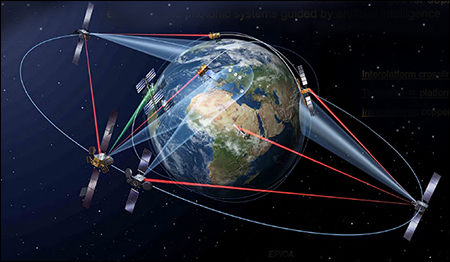EPICA anticipated to reach $5M in funding through support from industry, government agencies
Vanderbilt engineering researchers are part of a team that will lead a new five-year Industry-University Cooperative Research Centers Program in integrated photonics for aerospace applications that is anticipated to reach $5 million in funding.
Electronic-Photonic Integrated Circuits for Aerospace is a collaborative research center supported by the National Science Foundation and industrial partners and designed to capitalize on research and engagement among academic teams, government agencies and industry innovators.
 The NSF grant provides $450,000 base funding per year for EPICA. Additional funds will be provided by industry and government organizations. Currently, nine organizations have joined the center and the additional funding is expected to reach $500,000 a year. Center members vote to determine the research performed by the team. More than 10 semiconductor and photonics companies are expected to join the center in the next year.
The NSF grant provides $450,000 base funding per year for EPICA. Additional funds will be provided by industry and government organizations. Currently, nine organizations have joined the center and the additional funding is expected to reach $500,000 a year. Center members vote to determine the research performed by the team. More than 10 semiconductor and photonics companies are expected to join the center in the next year.
EPICA’s mission is to enable the use of integrated photonics and electronics in sensing and communications applications for spaceborne and aerospace platforms that have become essential technology infrastructure to support global communications, climate monitoring, sensing and exploration.
The three-university team includes Georgia Tech, the lead institution, and the University of Central Florida. The universities have complementary expertise and facilities to develop new space- and aircraft-specific components and architectures as well as understand the failure mechanisms when these systems are subject to extreme environments.
The Vanderbilt team will provide expertise in nanophotonics technologies and radiation effects characterization of center-wide components. Vanderbilt’s expertise in photonics and radiation-effects modeling and simulation as well as physical test and characterization will be applied to meet the goals of creating electronic-photonic integrated circuits suitable for operation in the harsh environments of space and aerospace application.

“Integration of silicon photonics with traditional electronics has well-known advantages for terrestrial applications. Our challenge is to perform research that enables integration of these technologies into high-reliability space and aerospace systems. The three EPICA universities form a unique team that is well suited to solve these problems,” said Robert Reed, the Vanderbilt EPICA site director and associate chair of the Department of Electrical and Computer Engineering.
The research team includes Ronald Schrimpf, Orrin H. Ingram Professor of Engineering and director of Vanderbilt Institute for Space and Defense Electronics; Sharon Weiss, Cornelius Vanderbilt Professor of Engineering and director of the Vanderbilt Institute of Nanoscale Science and Engineering; and Michael Alles, research professor of electrical engineering and ISDE associate director.
Vanderbilt is home to the world’s largest university-based radiation effects program through its space radiation institute and Radiation Effects Research Group in the School of Engineering. Vanderbilt also has a thriving nanophotonics research community that leverages resources in the Vanderbilt Institute of Nanoscale Science and Engineering–a multi-disciplinary institute that provides access to a state-of-the-art cleanroom and instrumentation for users from Vanderbilt, other external academic institutions and industry.
Contact: Brenda Ellis, 615 343-6314
brenda.ellis@vanderbilt.edu